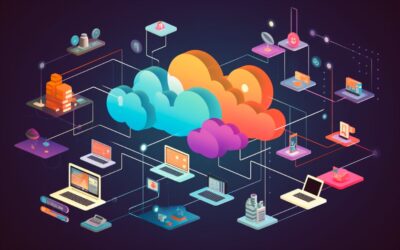The talent shortage could cost France more than 180 billion euros by 2030.¹ To counter this phenomenon and improve their attractiveness, many companies have understood that they need to invest in the employee experience. In 2021, which has seen an explosion in remote work, this means offering employees flexible and agile working arrangements. In other words: making work phygital.
This means giving employees the ability to work from anywhere, at any time, and from any type of device (PC, tablet, or cellphone).
This movement addresses several recurring questions about work methods:
- Why move to “phygital” work methods?
- What’s the impact on talent attraction and retention?
- On which concrete solutions can we rely?
The “phygital” experience : an inevitable evolution?
The word “phygital” first appeared about 10 years ago to describe modern consumers’ buying journeys as both physical and digital. Indeed, when consumers now go to stores, they also visit the store’s website and social networks to find information, ask for advice, or even finish their purchase. It’s a journey that’s difficult to predict. In other words: in the age of the digital consumer, there’s no longer any question of waiting for the customer in one place. Merchants must adopt an omnichannel approach. This means being present everywhere at the same time to guide customers through each step of their complex buying journey.
Switching to omnichannel marketing offers two distinct advantages:
- On the one hand, consumers have a homogeneous phygital experience—no matter which channels are chosen.
- On the other hand, consumers benefit from a journey best adapted to their individual buying habits and preferences.
Recently, the same reflection has been emerging when analyzing the evolution of work modes. Indeed, employees are also becoming more and more phygital. They work at the office, at home, or on public transportation, and on their PC, cell phone, or tablet—at any time of the day. Largely due to the rise of new technologies (such as the explosion of smartphones, popularity of the cloud), these new uses facilitate work in mobility and therefore contribute to its propagation.
The same holds true for businesses. To promote a fluid work experience and improve attractiveness on the job market, a company has to offer its employees omnichannel collaboration methods and tools. That means offering everyone the means to work from anywhere, at any time, using any device. The future of the employee experience is therefore inevitably phygital.
Also read: Marie-Christine Lanne: “All Digital, So All Phygital!”
Why invest in the phygital employee experience?
If you’re still not convinced, here are five good reasons to go for a phygital employee experience.
Attract and retain talent
The first reason to make work methods more flexible is to retain your best talent. You will thus demonstrate that you are a modern company that knows how to adapt to their changing expectations, and that you trust them. The same goes for the people you are looking to recruit. By offering attractive work methods, you will increase your chances of deciding in your favor. Indeed, the most digitized employees are generally quality profiles, who know how to be flexible in their work, are turned towards innovation and favor a culture of results. As a result, you’ll not only retain the talent you already have but also attract more qualified candidates, a win-win approach for the company.
Enhance your employer brand
Employees who are satisfied with their employers often become companies’ ambassadors: they frequently speak highly of their work and companies to those around them. But if they particularly appreciate their work environment, they can also talk about it on social networks or on platforms like Glassdoor. You’ll then be able to see a direct impact on your employer brand and your company’s image. Indeed, positive comments are often a good indicator of a pleasant atmosphere and working environment. This element will reassure a potential candidate that wants to join your company, and may even play an essential role in their decision making.
Nurture employee engagement
Just like the consumer, the employee is a market of one: the more individualized the approach, the more likely your employee will be satisfied. If the company offers a personalized work experience, adapted to employees’ phygital uses, they’ll be more efficient and will have more motivation in the company’s projects. Indeed, according to a study by the Gallup Institute, companies with a high level of commitment are 17% more productive. What’s more, they have a 41% lower absenteeism rate than those with low employee commitment.
Strengthen team cohesion
In addition, employees will be better able to create bonds among colleagues with the right tools at their disposal. The phygital experience will enhance the company’s ability to unite all employees, no matter where they are. For example, internal social networks will allow you to bring together employees from different departments into groups, and even (re)connect field workers (blue collars) with office workers (white collars). As you go along, you’ll be able to increase the sense of belonging and cohesion within your teams.
Improve the quality of life at work
Employees are increasingly aware of the quality of work life (QWL) that their company offers them. This well-being depends not only on the employee’s tasks, but also on the work environment, relations with colleagues/managers, and the effectiveness of the tools being used. By investing in suitable digital tools, you facilitate communication and collaboration among teams, thus improving quality of work life. In addition, employees will have more time to devote to their missions and feel less stressed at work.
The tools of the phygital company
Today, too many companies still use tools that are poorly connected to each other and sometimes even archaic. Email, for example, is often responsible for a loss of productivity when used intensively internally.
To succeed in their digital transformation, companies have to adopt tools that are more in line with the new ways in which employees work.
Tools that facilitate communication
Tools that facilitate communication have three main purposes: improving internal information flow, facilitating exchanges, and strengthening team cohesion. On platforms such as Talkspirit, Lumapps, Workplace or Mattermost, the internal life of the company is more dynamic, the successes of all parties are better valued, and exchanges include more participation. Everyone can express themselves to the business community. There is no longer a need to send an endless number of emails to exchange information, since employees can chat live or discuss via videoconference. Internal communication is also more effective. The company simply posts collective publications or shares a live video to keep employees informed of the latest news.
Collaborative platforms
Collaborative software such as Talkspirit, Jamespot, Teams or Slack will make it easier for teams to work, whether they are in the office, in the field or at home. For example, the manager can create checklists to assign tasks to each member of his team, and track the progress of different projects. No more dispersed information: your files are now centralized in one place. And you have the possibility to edit them in real time! This simplifies remote collaboration.
The digital workplace
For several years now, a new tool has stood out for its phygital and “all-in-one” dimension: the digital workplace. A true dematerialized office, this digital workspace allows employees to access their documents and business applications anywhere, anytime, and on the device of their choice. No need to juggle from one tool to another permanently, since your software is directly linked to the platform (natively or by integration). The digital workplace is therefore the ideal answer to the challenges of the phygital enterprise.
Also read: What are the Best Digital Workplace Solutions?
*
* *
Whether we like it or not, phygital is profoundly transforming the work habits of employees. Today, more than ever, technologies allow us to promote these new uses. So don’t wait to offer your talents a personalized phygital experience. Contact our team to discuss your projects.
¹2018 “The Talent Shift” study by the American recruitment firm Korn Ferry
–
Authors: Benoît Renoul, Emmanuelle Abensur



